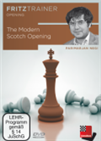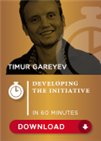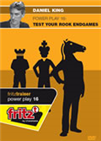Carlsen dominates first mini-match
The Lindores Abbey Chess Challenge started on May 18th. Twelve players are taking part. After a three-day preliminary, the best eight players will advance to the deciding knockout section. The time control is 15 minutes for the game, with a 10-second increment per move.
Hikaru Nakamura has mostly recovered from many years in which he had a markedly difficult time facing Magnus Carlsen, particularly in classical chess. At the 2016 Bilbao Chess Masters, the American ace defeated the world champion for the first time in a classical game, after having lost twelve times in their previous direct confrontations.
It must be noted, though, that a lot of people have a difficult time against the most dominating player of our era, and this is, after all, a rapid tournament. Nakamura is the current world number one in blitz and recently reached the final of the Magnus Carlsen Invitational, when he lost a closely disputed match against the Norwegian. Thus, seeing Carlsen get a 3:0 win in the first rubber is still surprising, given the circumstances.
Nakamura will get a chance to even the score on Friday, much like world number three Ding Liren, who lost the first mini-match of his semi-final against Daniil Dubov. Dubov did not shy away from showing his usual sharp style while facing the Chinese star. The Russian won games one and four to grab a 2½:1½ win.
There was no lack of excitement in both matches, as the players proved to be highly invested in reaching the finals of the Lindores Abbey Rapid Challenge.

Carlsen 3:0 Nakamura
Instead of the more common Italian or Ruy Lopez Openings, Carlsen opted for the Scotch with white in game one. He was ready to enter a sharp line, played earlier this year by Maksim Chigaev at the Gibraltar Masters:
 In this DVD, Parimarjan Negi looks at the latest revolution in Scotch theory that has completely changed white’s plans, and once again brought back the interest of the world’s elite.
In this DVD, Parimarjan Negi looks at the latest revolution in Scotch theory that has completely changed white’s plans, and once again brought back the interest of the world’s elite.
The world champion uncorked 9.0-0-0, entering territories that have not been heavily explored. Back in January, Chen Qi had responded to long castle with 9...Qe7, and had eventually obtained a full point. Nakamura, on the other hand, immediately exchanged the queens with 9...Qxf3, and the game continued 10.gxf3 Ne7 11.h4 Bxc3 12.bxc3 — White had the bishop pair and two pairs of doubled pawns.
Carlsen also had the initiative, and he used it to reach a favourable bishop endgame. It was not obvious that he would be able to convert it into a win, though. On move 29, however, Nakamura erred by breaking open the queenside:
Black is not in time to win a potential race of passers after 29...b6 30.axb6 cxb6 due to 31.Bxa6, when White is willing to give up his bishop after 31...b5. Carlsen had correctly evaluated this position and went on to prove his central passers were too much for Black's bishop and king to handle.
Game two was a highly strategical battle in which Carlsen, playing black, got the upper hand in the middlegame. The world champion later noted he had made some inaccurate moves during this encounter, but his overall steady play was enough to get a two-point advantage in the mini-match.
Thus, Nakamura had black in a must-win situation, and fearlessly played the Hippopotamus Defence (1...g6, 2...d6, 3...Bg7, 4...e6, 5...h6), emphasizing his desire to go all-in by quickly expanding on the kingside with 6...g5. Carlsen thought his opponent's approach was appropriate, but had no trouble neutralizing Black's attempts. Nakamura kept stepping away from any drawing line, which led to him losing a third straight game against an inspired world champion.
Select an entry from the list to switch between games
Dubov 2½:1½ Ding
After eliminating Sergey Karjakin in the quarter-finals, Dubov talked to the commentators and repeatedly pointed out that he has a distinctly bad score against his Chinese colleagues. Facing China's number one, however, he kicked off the semi-finals with a nice win. He had a strong initiative with white, and once Ding allowed White's queen to infiltrate his camp there was little doubt about the result:
 Dynamic play is what makes your chess effective and most importantly fun! Timur Gareyev shows severeal examples which aspects are important to remember when seizing for the initiative!
Dynamic play is what makes your chess effective and most importantly fun! Timur Gareyev shows severeal examples which aspects are important to remember when seizing for the initiative!
Dubov's 15.f4 was very strong, and with no clear active plan to move forward Ding opted for 15...Nd5 in the diagrammed position, allowing 16.Qh5. Giving Dubov such a strong initiative is never a good idea. The Russian continued upping the pressure, and Ding decided to concede defeat only four moves later.
The Chinese bounced back immediately, showcasing his usual ruthlessness when he gets a positionally superior setup with the white pieces. A draw in game three meant Ding had the last chance to go for a win with white, but in the end it was Dubov who got the victory. In a classical game, it is very likely that Ding would have held the balance in the following rook endgame a pawn down:
 The aim of this DVD is to provide you with the practical skills and knowledge that you will need to play a rook and pawn endgame. Based on his own playing experience, Grandmaster Daniel King reveals what is essential knowledge, saving you time in your studies. The Power Play series is suitable for anyone looking to improve their chess, but also provides ready-made lessons and exercises for a trainer.
The aim of this DVD is to provide you with the practical skills and knowledge that you will need to play a rook and pawn endgame. Based on his own playing experience, Grandmaster Daniel King reveals what is essential knowledge, saving you time in your studies. The Power Play series is suitable for anyone looking to improve their chess, but also provides ready-made lessons and exercises for a trainer.
Running time: 5 hours
It was not meant to be for Ding in the fourth rapid game of the day, though. The world number three will get a chance to even the score in Friday's second rubber.
Select an entry from the list to switch between games
Links
























